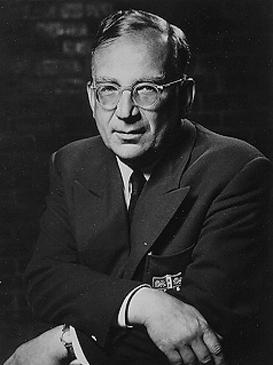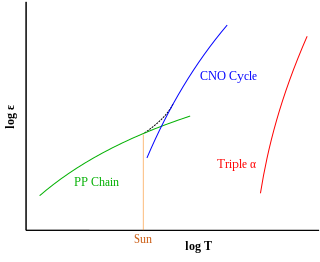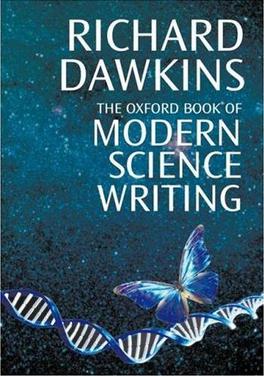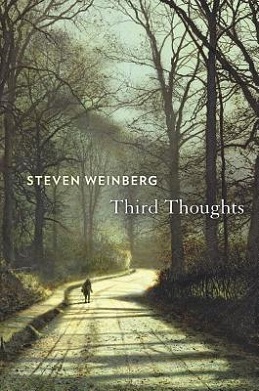
In cosmology, the cosmological constant, alternatively called Einstein's cosmological constant, is the constant coefficient of a term that Albert Einstein temporarily added to his field equations of general relativity. He later removed it, however much later it was revived and reinterpreted as the energy density of space, or vacuum energy, that arises in quantum mechanics. It is closely associated with the concept of dark energy.

George Gamow, sometimes Gammoff; born Georgiy Antonovich Gamov was a Soviet and American polymath, theoretical physicist and cosmologist. He was an early advocate and developer of Lemaître's Big Bang theory. Gamow discovered a theoretical explanation of alpha decay by quantum tunneling, invented the liquid drop model and the first mathematical model of the atomic nucleus, worked on radioactive decay, star formation, stellar nucleosynthesis, Big Bang nucleosynthesis, and molecular genetics.

Stellar nucleosynthesis is the creation (nucleosynthesis) of chemical elements by nuclear fusion reactions within stars. Stellar nucleosynthesis has occurred since the original creation of hydrogen, helium and lithium during the Big Bang. As a predictive theory, it yields accurate estimates of the observed abundances of the elements. It explains why the observed abundances of elements change over time and why some elements and their isotopes are much more abundant than others. The theory was initially proposed by Fred Hoyle in 1946, who later refined it in 1954. Further advances were made, especially to nucleosynthesis by neutron capture of the elements heavier than iron, by Margaret and Geoffrey Burbidge, William Alfred Fowler and Fred Hoyle in their famous 1957 B2FH paper, which became one of the most heavily cited papers in astrophysics history.

Steven Weinberg was an American theoretical physicist and Nobel laureate in physics for his contributions with Abdus Salam and Sheldon Glashow to the unification of the weak force and electromagnetic interaction between elementary particles.

Astrophysics is a science that employs the methods and principles of physics and chemistry in the study of astronomical objects and phenomena. As one of the founders of the discipline, James Keeler, said, Astrophysics "seeks to ascertain the nature of the heavenly bodies, rather than their positions or motions in space–what they are, rather than where they are." Among the subjects studied are the Sun, other stars, galaxies, extrasolar planets, the interstellar medium and the cosmic microwave background. Emissions from these objects are examined across all parts of the electromagnetic spectrum, and the properties examined include luminosity, density, temperature, and chemical composition. Because astrophysics is a very broad subject, astrophysicists apply concepts and methods from many disciplines of physics, including classical mechanics, electromagnetism, statistical mechanics, thermodynamics, quantum mechanics, relativity, nuclear and particle physics, and atomic and molecular physics.

Leonard Susskind is an American theoretical physicist, Professor of theoretical physics at Stanford University and founding director of the Stanford Institute for Theoretical Physics. His research interests are string theory, quantum field theory, quantum statistical mechanics and quantum cosmology. He is a member of the US National Academy of Sciences, and the American Academy of Arts and Sciences, an associate member of the faculty of Canada's Perimeter Institute for Theoretical Physics, and a distinguished professor of the Korea Institute for Advanced Study.

Ralph Asher Alpher was an American cosmologist, who carried out pioneering work in the early 1950s on the Big Bang model, including Big Bang nucleosynthesis and predictions of the cosmic microwave background radiation.
In physical cosmology, the Alpher–Bethe–Gamow paper, or αβγ paper, was created by Ralph Alpher, then a physics PhD student, his advisor George Gamow, and Hans Bethe. The work, which would become the subject of Alpher's PhD dissertation, argued that the Big Bang would create hydrogen, helium and heavier elements in the correct proportions to explain their abundance in the early universe. While the original theory neglected a number of processes important to the formation of heavy elements, subsequent developments showed that Big Bang nucleosynthesis is consistent with the observed constraints on all primordial elements.
In astroparticle physics, an Urca process is a reaction which emits a neutrino and which is assumed to take part in cooling processes in neutron stars and white dwarfs. The process was first discussed by George Gamow and Mário Schenberg while they were visiting a casino named Cassino da Urca in Urca, Rio de Janeiro. As Gamow recounts in his autobiography, the name was chosen in part to commemorate the gambling establishment where the two physicists had first met, and "partially because the Urca Process results in a rapid disappearance of thermal energy from the interior of a star, similar to the rapid disappearance of money from the pockets of the gamblers on the Casino de Urca." In Gamow's South Russian dialect, urca can also mean a robber or gangster.

Nuclear astrophysics is an interdisciplinary part of both nuclear physics and astrophysics, involving close collaboration among researchers in various subfields of each of these fields. This includes, notably, nuclear reactions and their rates as they occur in cosmic environments, and modeling of astrophysical objects where these nuclear reactions may occur, but also considerations of cosmic evolution of isotopic and elemental composition (often called chemical evolution). Constraints from observations involve multiple messengers, all across the electromagnetic spectrum (nuclear gamma-rays, X-rays, optical, and radio/sub-mm astronomy), as well as isotopic measurements of solar-system materials such as meteorites and their stardust inclusions, cosmic rays, material deposits on Earth and Moon). Nuclear physics experiments address stability (i.e., lifetimes and masses) for atomic nuclei well beyond the regime of stable nuclides into the realm of radioactive/unstable nuclei, almost to the limits of bound nuclei (the drip lines), and under high density (up to neutron star matter) and high temperature (plasma temperatures up to 109 K). Theories and simulations are essential parts herein, as cosmic nuclear reaction environments cannot be realized, but at best partially approximated by experiments. In general terms, nuclear astrophysics aims to understand the origin of the chemical elements and isotopes, and the role of nuclear energy generation, in cosmic sources such as stars, supernovae, novae, and violent binary-star interactions.
The B2FH paper was a landmark scientific paper on the origin of the chemical elements. The paper's title is Synthesis of the Elements in Stars, but it became known as B2FH from the initials of its authors: Margaret Burbidge, Geoffrey Burbidge, William A. Fowler, and Fred Hoyle. It was written from 1955 to 1956 at the University of Cambridge and Caltech, then published in Reviews of Modern Physics in 1957.

The Mysterious Universe is a popular science book by the British astrophysicist Sir James Jeans, first published in 1930 by the Cambridge University Press. In the United States, it was published by Macmillan.

The Oxford Book of Modern Science Writing is an anthology of scientific writings, arranged and introduced by Richard Dawkins of the University of Oxford. Published first in March 2008, it contains 83 writings on many topics from a diverse variety of authors, which range in length from one to eight pages. All inclusions are dated post-1900, and include poetry, anecdotes, and general philosophical musings.

Omega1 Aquilae, which is Latinized from ω1 Aquilae, is the Bayer designation for a single star in the equatorial constellation of Aquila. With an apparent visual magnitude of 5.2 it is a faint, yellow-white hued star that can be seen with the naked eye in dark skies. From the annual parallax shift of 8.53 mas, the distance to this star can be estimated as 382 light-years, give or take a 6 light year margin of error. It is drifting closer to the Sun with a radial velocity of −14 km/s.

The First Three Minutes: A Modern View of the Origin of the Universe is a book by American physicist and Nobel Laureate Steven Weinberg.

One Two Three... Infinity: Facts and Speculations of Science is a popular science book by theoretical physicist George Gamow, first published in 1947, but still available in print and electronic formats. The book explores a wide range of fundamental concepts in mathematics and science, written at a level understandable by middle school students up through "intelligent layman" adults. The book includes many handmade illustrations by Gamow.

On a Piece of Chalk was a lecture given by Thomas Henry Huxley on 26 August 1868 to the working men of Norwich during a meeting of the British Association for the Advancement of Science. It was published as an essay in Macmillan's Magazine in London later that year. The piece reconstructs the geological history of Britain from a simple piece of chalk and demonstrates science as "organized common sense".

The Inflationary Universe is a popular science book by theoretical physicist Alan Guth, first published in 1997. The book explores the theory of inflation, which was first presented by the author in 1979.
The Utrecht Atlas of the solar spectrum is a detailed inventory in graphical form of spectral lines observed in sunlight at the Sonnenborgh Observatory. The visible spectrum is about 390 to 700 nm and the atlas covers from 361.2 to 877.1 nm so that the atlas has some coverage of the infrared and ultraviolet spectrum of sunlight. The atlas, compiled by Minnaert and his students Mulders and Houtgast, was published in 1940 shortly before the WWII invasion of the Netherlands.
The Atlas contains intensity curves covering the complete solar spectrum from λ 3612 to λ 8771 based on photographs taken at the Mount Wilson Observatory together with an appendix covering the region λ 3332 to λ 3637 as derived from plates secured at Utrecht. The scale in wave length is about 20 millimeters per angstrom so that the spectrum is represented on a map about 360 feet long. The curves are printed in black on millimeter paper with blue lines. The intensity scale is such that a vertical range of 100 millimeters corresponds to the difference between zero intensity and the continuous background.
The atlas had a huge influence on solar and stellar high resolution spectroscopy after World War II.

Third Thoughts is a 2018 book of 25 essays written by Steven Weinberg, mostly in the decade preceding 2018. Most of the essays were previously published in The New York Review of Books, newspapers, and other periodicals. Essays numbered 20, 23, 24, and 25 are published for the first time in the book. Essay number 6 is the foreword to the 2014 book Time in Powers of Ten. There are 8 essays in the section on science history, 6 essays in the section on physics and cosmology, 6 essays in the section on public matters, and 5 essays in the section on personal matters.
















